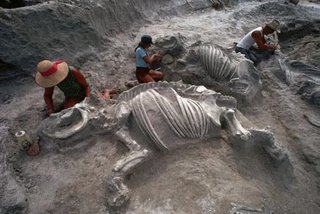Rareresource
Monday, December 22, 2008
Fossil "Pompeii" of Prehistoric

In 1971 he found a skull of a rhino calf protruding from an eroding ravine. The skull turned out to be part of a complete skeleton embedded in volcanic ash.
Voorhies led excavations of the site in 1978 and 1979, supported by a grant from the National Geographic Society's Committee for Research and Exploration. (National Geographic News is part of the National Geographic Society.)
About 12 million years ago, a volcano in modern-day Idaho spread a blanket of ash over large parts of what is now the midwestern United States. A layer of this powdered glass one or two feet (one- to two-thirds of a meter) thick covered the grasslands of northeastern Nebraska.
Most of the animals living in the area survived the actual ashfall, but as they continued to graze on the ash-covered grasses, their lungs began to fill with the deadly particles.

